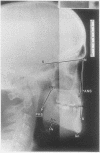Abstract
Cephalometry is often used to assess patients with sleep apnoea but whether these measurements differ from those in non-apnoeic snorers and how they are influenced by age is not clear. Cephalometric radiographs of patients with sleep apnoea were compared with those of snorers without sleep apnoea and those of non-snorers. Fifty two snorers with suspected sleep apnoea had a conventional sleep study and were divided into two groups: those with an apnoea-hypopnoea index greater than 10/h (n = 40, sleep apnoea group) and those whose apnoea-hypopnoea index was 10/h or less (n = 12, snorer group). The cephalometric measurements in these patients were compared with those of 34 non-snoring control subjects. Controls were subdivided into two groups: control group 1 included 17 subjects similar in age to the sleep apnoea and snorer groups (mean (SD) age 50.0 (10.9), 50.7 (9.4), and 50.6 (9.7) years); control group 2 included 15 young men (25.4 (2.6) years). The distance from the mandibular plane to the hyoid bone (MP-H) and the length of the soft palate were greater in the patients with sleep apnoea (28.7 (7.8) and 43.6 (5.0) mm) than in the snorers (23.7 (4.2) and 40.3 (4.9 mm). The MP-H was similar in snorers and age matched control subjects, but was significantly greater in the older than in the younger control subjects (22.1 (6.1) vs 17.0 (6.8]. The soft palate was longer in subjects who snored (both sleep apnoea patients and snorers) than in control subjects. The MP-H distance significantly correlated with age for all subjects (snorers and controls) and for the control subjects alone. This study shows that non-apnoeic snorers have cephalometric abnormalities that differ from those of patients with sleep apnoea and that cephalometric values are influenced by the subject's age.
Full text
PDF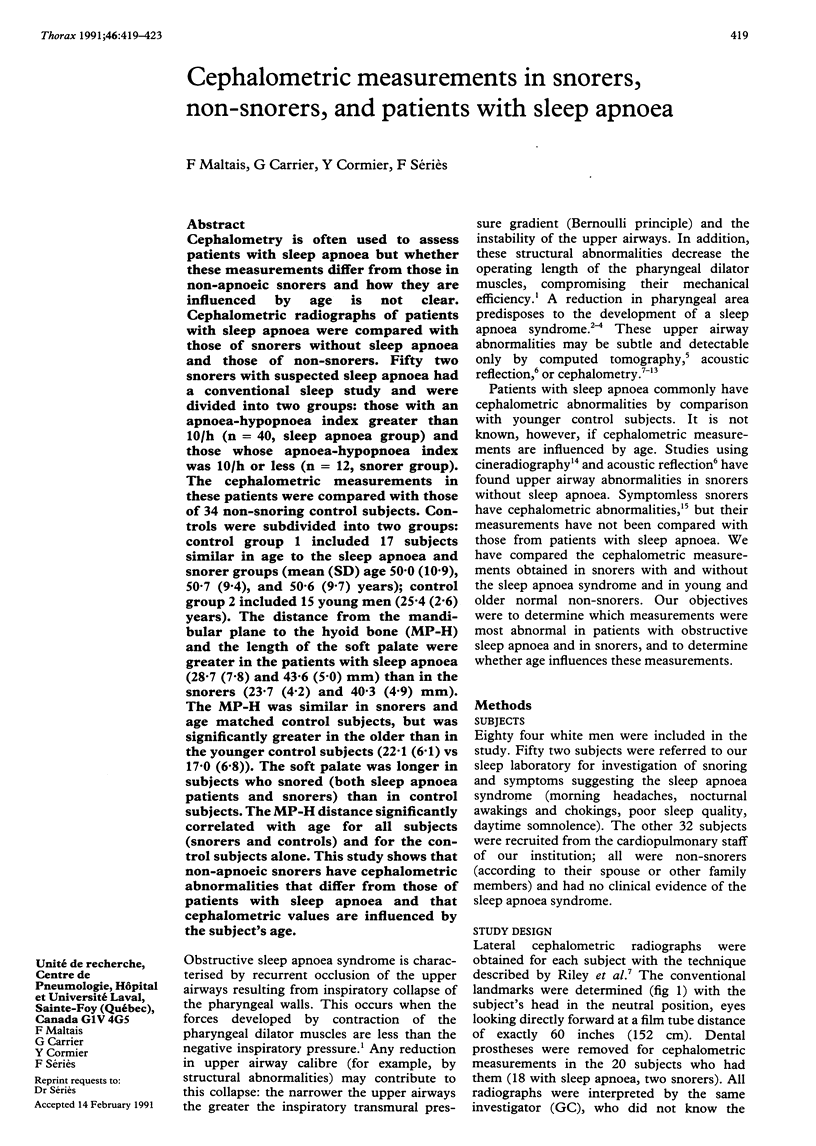
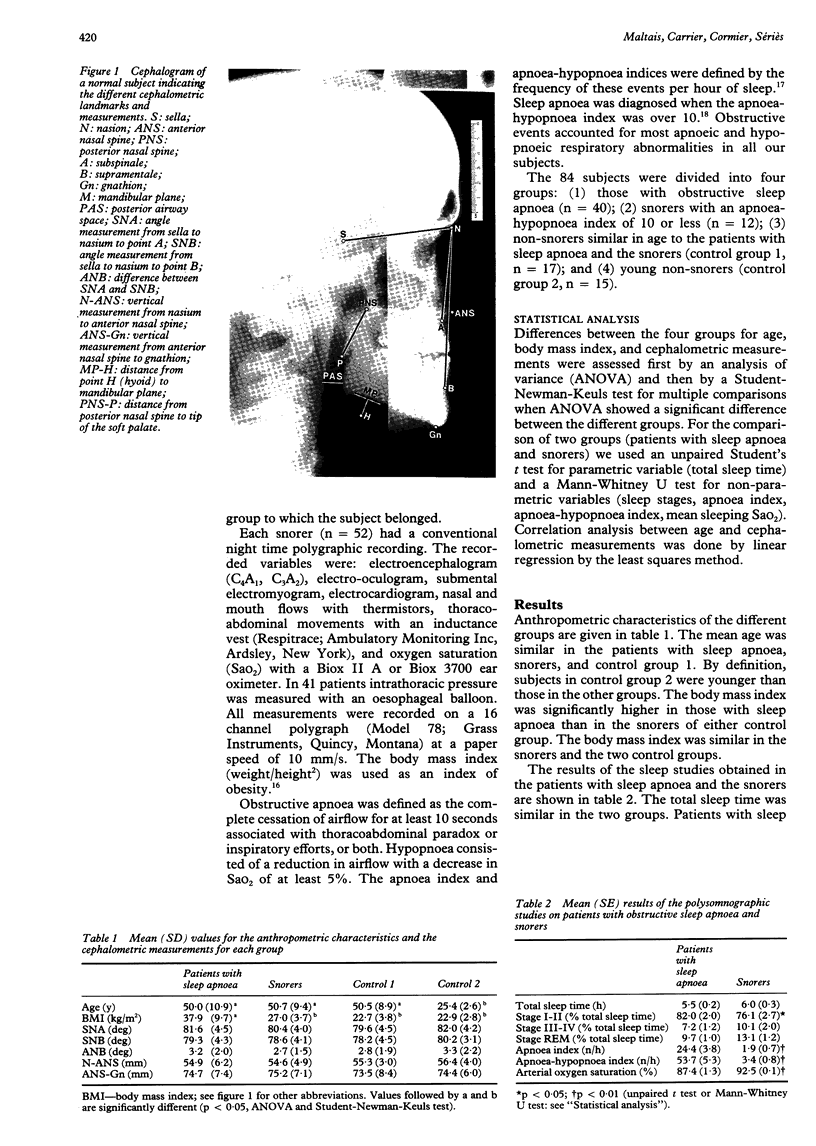

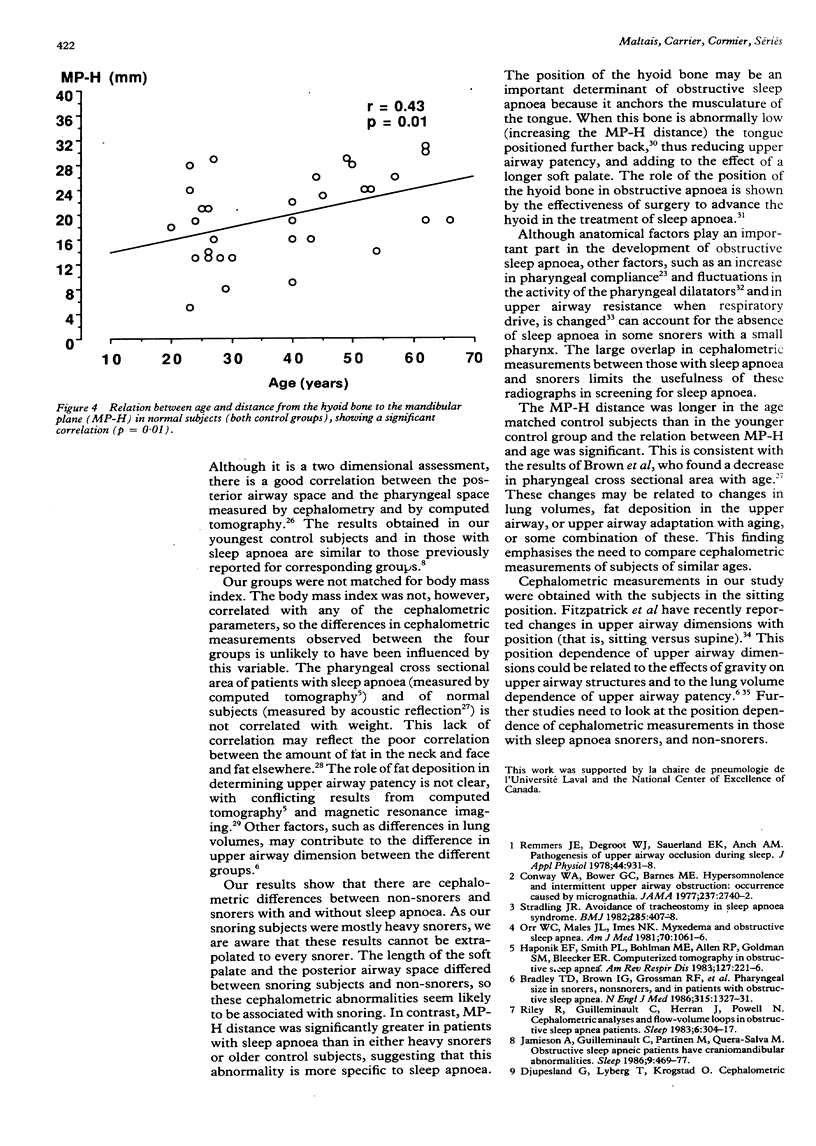
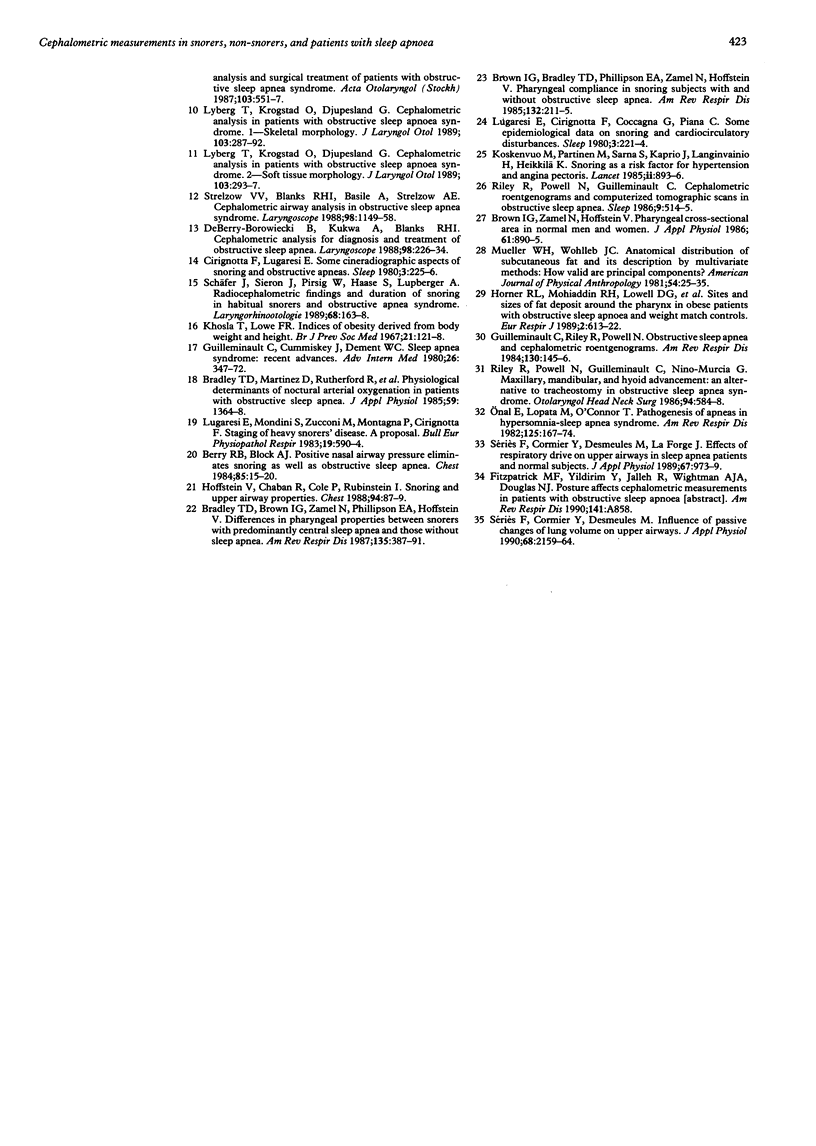
Images in this article
Selected References
These references are in PubMed. This may not be the complete list of references from this article.
- Berry R. B., Block A. J. Positive nasal airway pressure eliminates snoring as well as obstructive sleep apnea. Chest. 1984 Jan;85(1):15–20. doi: 10.1378/chest.85.1.15. [DOI] [PubMed] [Google Scholar]
- Bradley T. D., Brown I. G., Grossman R. F., Zamel N., Martinez D., Phillipson E. A., Hoffstein V. Pharyngeal size in snorers, nonsnorers, and patients with obstructive sleep apnea. N Engl J Med. 1986 Nov 20;315(21):1327–1331. doi: 10.1056/NEJM198611203152105. [DOI] [PubMed] [Google Scholar]
- Bradley T. D., Brown I. G., Zamel N., Phillipson E. A., Hoffstein V. Differences in pharyngeal properties between snorers with predominantly central sleep apnea and those without sleep apnea. Am Rev Respir Dis. 1987 Feb;135(2):387–391. doi: 10.1164/arrd.1987.135.2.387. [DOI] [PubMed] [Google Scholar]
- Bradley T. D., Martinez D., Rutherford R., Lue F., Grossman R. F., Moldofsky H., Zamel N., Phillipson E. A. Physiological determinants of nocturnal arterial oxygenation in patients with obstructive sleep apnea. J Appl Physiol (1985) 1985 Nov;59(5):1364–1368. doi: 10.1152/jappl.1985.59.5.1364. [DOI] [PubMed] [Google Scholar]
- Brown I. G., Zamel N., Hoffstein V. Pharyngeal cross-sectional area in normal men and women. J Appl Physiol (1985) 1986 Sep;61(3):890–895. doi: 10.1152/jappl.1986.61.3.890. [DOI] [PubMed] [Google Scholar]
- Cirignotta F., Lugaresi E. Some cineradiographic aspects of snoring and obstructive apneas. Sleep. 1980;3(3-4):225–226. [PubMed] [Google Scholar]
- Conway W. A., Bower G. C., Barnes M. E. Hypersomnolence and intermittent upper airway obstruction. Occurrence caused by micrognathia. JAMA. 1977 Jun 20;237(25):2740–2742. [PubMed] [Google Scholar]
- Guilleminault C., Cummiskey J., Dement W. C. Sleep apnea syndrome: recent advances. Adv Intern Med. 1980;26:347–372. [PubMed] [Google Scholar]
- Guilleminault C., Riley R., Powell N. Obstructive sleep apnea and cephalometric roentgenograms. Am Rev Respir Dis. 1984 Jul;130(1):145–146. doi: 10.1164/arrd.1984.130.1.145c. [DOI] [PubMed] [Google Scholar]
- Haponik E. F., Smith P. L., Bohlman M. E., Allen R. P., Goldman S. M., Bleecker E. R. Computerized tomography in obstructive sleep apnea. Correlation of airway size with physiology during sleep and wakefulness. Am Rev Respir Dis. 1983 Feb;127(2):221–226. doi: 10.1164/arrd.1983.127.2.221. [DOI] [PubMed] [Google Scholar]
- Hoffstein V., Chaban R., Cole P., Rubinstein I. Snoring and upper airway properties. Chest. 1988 Jul;94(1):87–89. doi: 10.1378/chest.94.1.87. [DOI] [PubMed] [Google Scholar]
- Horner R. L., Mohiaddin R. H., Lowell D. G., Shea S. A., Burman E. D., Longmore D. B., Guz A. Sites and sizes of fat deposits around the pharynx in obese patients with obstructive sleep apnoea and weight matched controls. Eur Respir J. 1989 Jul;2(7):613–622. [PubMed] [Google Scholar]
- Jamieson A., Guilleminault C., Partinen M., Quera-Salva M. A. Obstructive sleep apneic patients have craniomandibular abnormalities. Sleep. 1986 Dec;9(4):469–477. doi: 10.1093/sleep/9.4.469. [DOI] [PubMed] [Google Scholar]
- Koskenvuo M., Kaprio J., Partinen M., Langinvainio H., Sarna S., Heikkilä K. Snoring as a risk factor for hypertension and angina pectoris. Lancet. 1985 Apr 20;1(8434):893–896. doi: 10.1016/s0140-6736(85)91672-1. [DOI] [PubMed] [Google Scholar]
- Lugaresi E., Cirignotta F., Coccagna G., Piana C. Some epidemiological data on snoring and cardiocirculatory disturbances. Sleep. 1980;3(3-4):221–224. doi: 10.1093/sleep/3.3-4.221. [DOI] [PubMed] [Google Scholar]
- Lugaresi E., Mondini S., Zucconi M., Montagna P., Cirignotta F. Staging of heavy snorers' disease. A proposal. Bull Eur Physiopathol Respir. 1983 Nov-Dec;19(6):590–594. [PubMed] [Google Scholar]
- Lyberg T., Krogstad O., Djupesland G. Cephalometric analysis in patients with obstructive sleep apnoea syndrome. I. Skeletal morphology. J Laryngol Otol. 1989 Mar;103(3):287–292. doi: 10.1017/s0022215100108734. [DOI] [PubMed] [Google Scholar]
- Lyberg T., Krogstad O., Djupesland G. Cephalometric analysis in patients with obstructive sleep apnoea syndrome: II. Soft tissue morphology. J Laryngol Otol. 1989 Mar;103(3):293–297. doi: 10.1017/s0022215100108746. [DOI] [PubMed] [Google Scholar]
- Mueller W. H., Wohlleb J. C. Anatomical distribution of subcutaneous fat and its description by multivariate methods: how valid are principal components? Am J Phys Anthropol. 1981 Jan;54(1):25–35. doi: 10.1002/ajpa.1330540104. [DOI] [PubMed] [Google Scholar]
- Onal E., Lopata M., O'Connor T. Pathogenesis of apneas in hypersomnia-sleep apnea syndrome. Am Rev Respir Dis. 1982 Feb;125(2):167–174. doi: 10.1164/arrd.1982.125.2.167. [DOI] [PubMed] [Google Scholar]
- Orr W. C., Males J. L., Imes N. K. Myxedema and obstructive sleep apnea. Am J Med. 1981 May;70(5):1061–1066. doi: 10.1016/0002-9343(81)90867-6. [DOI] [PubMed] [Google Scholar]
- Remmers J. E., deGroot W. J., Sauerland E. K., Anch A. M. Pathogenesis of upper airway occlusion during sleep. J Appl Physiol Respir Environ Exerc Physiol. 1978 Jun;44(6):931–938. doi: 10.1152/jappl.1978.44.6.931. [DOI] [PubMed] [Google Scholar]
- Riley R. W., Powell N. B., Guilleminault C., Nino-Murcia G. Maxillary, mandibular, and hyoid advancement: an alternative to tracheostomy in obstructive sleep apnea syndrome. Otolaryngol Head Neck Surg. 1986 Jun;94(5):584–588. doi: 10.1177/019459988609400509. [DOI] [PubMed] [Google Scholar]
- Riley R., Powell N., Guilleminault C. Cephalometric roentgenograms and computerized tomographic scans in obstructive sleep apnea. Sleep. 1986 Dec;9(4):514–515. doi: 10.1093/sleep/9.4.514. [DOI] [PubMed] [Google Scholar]
- Schäfer J., Sieron J., Pirsig W., Haase S., Lupberger A. Radiokephalometrische Befunde und Schnarchdauer beim habituellen Schnarchen und obstruktiven Apnoe-Syndrom. Laryngorhinootologie. 1989 Mar;68(3):163–168. doi: 10.1055/s-2007-998310. [DOI] [PubMed] [Google Scholar]
- Stradling J. R. Avoidance of tracheostomy in sleep apnoea syndrome. Br Med J (Clin Res Ed) 1982 Aug 7;285(6339):407–408. doi: 10.1136/bmj.285.6339.407. [DOI] [PMC free article] [PubMed] [Google Scholar]
- Strelzow V. V., Blanks R. H., Basile A., Strelzow A. E. Cephalometric airway analysis in obstructive sleep apnea syndrome. Laryngoscope. 1988 Nov;98(11):1149–1158. doi: 10.1288/00005537-198811000-00001. [DOI] [PubMed] [Google Scholar]
- Sériès F., Cormier Y., Desmeules M. Influence of passive changes of lung volume on upper airways. J Appl Physiol (1985) 1990 May;68(5):2159–2164. doi: 10.1152/jappl.1990.68.5.2159. [DOI] [PubMed] [Google Scholar]
- Sériès F., Cormier Y., Desmeules M., La Forge J. Effects of respiratory drive on upper airways in sleep apnea patients and normal subjects. J Appl Physiol (1985) 1989 Sep;67(3):973–979. doi: 10.1152/jappl.1989.67.3.973. [DOI] [PubMed] [Google Scholar]
- deBerry-Borowiecki B., Kukwa A., Blanks R. H. Cephalometric analysis for diagnosis and treatment of obstructive sleep apnea. Laryngoscope. 1988 Feb;98(2):226–234. doi: 10.1288/00005537-198802000-00021. [DOI] [PubMed] [Google Scholar]



